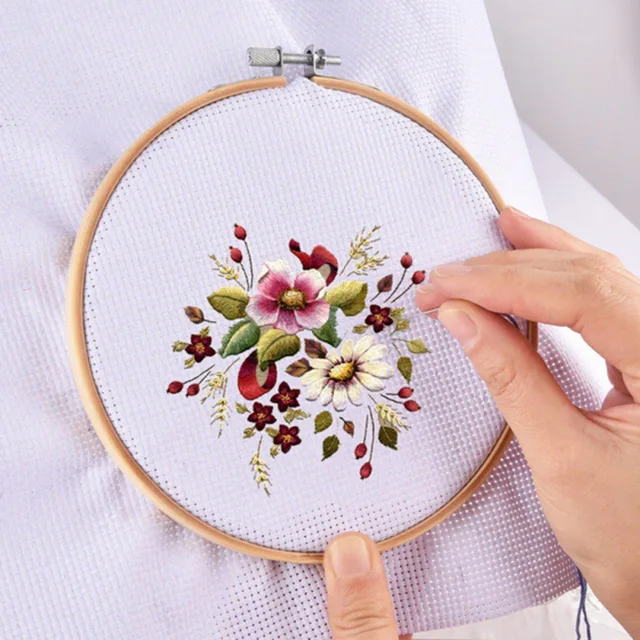Introduction
Needle craft comprises of sewing, knitting and crocheting, these create beautiful clothing items, upholstery materials and items for decoration, which you can use personally or sell or make some money.
Sewing or stitching, knitting and crocheting are crafts that can be done either by hand or by the use of machine. They all produce clothing, household furnishing and decorative pieces that can be worn or used around the house. They all use thread or yarn but the basic difference is in the tool that are used to make them. For instance, hand stitching uses needles.
In this article the following topics will be discussed:
- Simple sewing, knitting and crocheting
- Use of simple sewing tools and equipment
- Sewing basic stitches
- Simple decorative stitches
- Simple clothing construction process (seams)
Simple sewing, knitting and crocheting
Learning objectives
- Identify simple sewing, knitting and crocheting materials and tools
- Mention the uses and care of each tool;
- Name common articles made by sewing, knitting and crocheting
simple sewing, knitting and crocheting tools
Sewing or stitching is fastening of cloth, leather, fur, bark or other flexible materials using a needle and thread. It is either done by hand or by a sewing machine. Knitting, on the other hand, employs the use of pins and yarn in creating objects of clothing such as hats, sweaters, gloves, booties, belts, head bands and blankets. Knitting consists of loops called stitches pulled through each other. The active stitches are held on a needle until another loop can be passed through them, this process creates clothing.

Crocheting is a process of creating fabrics from yarn or thread using a crochet hook. Tools used for these simple crafts include sewing machine, sewing needles, scissors, pinking shears, tape rule, knitting pins, crochet hook, rivets, pin cushion, yarn and thread.
There are several types of sewing needles, but for most hand sewing, sharps are best. Between are shorter in length and are used for fine hand work. The sewing machine produces beautiful stitches, for a sewing machine to produce good stitching, it is necessary to understand how the sewing machine works. Study the instruction booklet carefully before you start to use a sewing machine.
uses and care of simple sewing knitting and crocheting tools
Needles are used by applying stitches to areas of clothing item o be repaired such as mending a seam or replacing a loose button. A sewing machine is used in the sewing of garments, household furnishing such as curtains, bedclothes, upholsteries and table linens. Knitting pins are of different sizes depending on what is knitted. The yarns also vary in thickness as to what effect we want to create by what we make. In crocheting we use hooks of different sizes. The fine crochet pin produces delicate patterns, while the bulky or thick pin produces big textured designs.
Needles for sewing are safer when stuck to a pin cushion. Knitting pins and crochet pins are kept in a sewing kit made of wood or plastic. Storing them this way allows easy access to them when you need them, these tools must be kept in good condition to render them safe and functional each time you need to use any of them.
Generally, tools used for needle craft are safe if kept in a sewing box or a basket in order to have them within reach when needed. This also helps to prolong their usage, proper storage can also help to prevent accidents which these tools can cause.
common articles made by sewing knitting and crocheting
- Sewing is used primarily to produce clothing and household furnishings such as curtains, bed clothes, upholsteries, table linens and garments.
- Knitting can be used to produce hats, booties for babies, sweaters, bonnet, mitts, hats, belts, head bands, gloves and socks.
- Crocheting can produce table runner, table cloths, borders for dresses or shirts. You can crochet just about anything that knitting can produce.
Evaluation questions
- Mention two tools each used for sewing, crocheting and knitting
- Name three articles each that can be produced by sewing, crocheting and knitting
- How can you take care of tools used for:
- Sewing
- Knitting
- Crocheting
Activities
- Examine, identify and name simple sewing, knitting and crocheting tools
- Pupils should practice the use of the above mentioned tools to produce simple article such as caps and booties
- Display the finished products in the class
uses of simple sewing tools and equipment
Learning objectives
At the end of this module, pupils should be able to:
- Identify tools and equipment for sewing;
- State the uses of simple sewing tools and equipment;
- Practice how to handle needle and thread;
- Practice how to thread the needle quickly and correctly.
simple tools and equipment
There are quite a number of tools and equipment used for needle craft, each has its place and usefulness, its care and handling for good efficiency in the tasks, which they are used to perform.
These tools are many but we shall consider only a number of simple ones, namely: sewing machine, bobbin, dress maker’s or tailor’s chalk, tape measure, needle, pattern pin, pin cushion, scissor, pinking shears, seam ripper, sewing table, thimble, thread/yarn, brown paper, tracing wheel, sewing box or basket, the steam iron, the ironing board, the pressing cloth, spools of thread, shears.
: the sewing machine
A sewing machine is used to stitch fabric or other material together with thread. Sewing machines were invented long ago during the first industrial revolution to reduce the amount of manual sewing work performed by clothing companies. They have greatly improved the efficiency and productivity of fabrics and clothing industries since the invention of the first sewing machine.
The main stitch of most older machines, chain stitch, has one major drawback: it is weak and the stitch can easily be pulled apart. As machines were being used, people realized that a stitch more. Suited to machine production was needed, this led to the creation of lock stitches.
A lock stitch is created by two separate threads interlocking through the two layers of fabric, resulting in a stronger, sturdier stitch that looks the same from both sides of the fabrics. Sewing machines made today are of different types, hand operated, those operated by foot pedals or those that are electric. They are capable of producing a great variety of plain or patterned stitches.
uses of simple sewing equipment and tools
- The sewing machine: this is used for making or mending clothes or household linens. It can also carry out fancy sewing which are decorative, including patterns such as shirring, smocking embroidery or quilting
- A sew table for a sewing machine: this is like a writing table on which the sewing machine is placed for us. The height must be right and the space sufficient for activities related to the job of sewing to be easily carried out.
- Stitching awl: this is a pointed tool for making small holes.
- Bobbin: this is a cylinder or spindle for holding or dispensing thread
- Bodkin: bodkin is a blunt needle for drawing a tape of ribbon through a loop or hem.
- Dressmaker’s or tailor’s shear: these are large than the ordinary and are also very sharp for a good job of cutting fan precisely
- Tape measure: this does all the work of measuring people, objects or cloth. It is usually 60 inches in length and half an inch wide.
- Needles: when threaded, they are used for mending or making clothing or household linens
- Brown paper: patterns, of whatever need, to be made are cut out on brown paper. The pattern is then placed on a piece of cloth to cut out and sew. This process ensures that a guide is provided for whatever style to be made.
- Seam ripper: this is used to remove stitches that are incorrectly used on clothing
- Thread or yarn: these are used when needed, both work together to mend or make clothing
- Tailor’s chalk: this is used when a pattern is made, or used to trace out patterns on a piece of cloth to be sewn
- Sewing box: this is used for the storage of all needle craft tools and accessories
- Pins: these are used to hold two pieces of clothes together while we sew them. They keep the pieces together without allowing shifting while we sew them together.
- Iron and ironing board: every stage in clothing requires pressing. The ironing boards supply the platform on which the iron does the pressing.
using simple sewing tools and equipment
The following points are important when using simple sewing tools and equipment:
- The use of simple sewing tools and equipment render sewing pleasurable and easy. Using the sewing machine at the right height prevents fatigue.
- Storage of tools and equipment in a designated place allows them to be within reach when you need them. A sewing box or basket stores all the tools needed for sewing.
- Sewing tools and equipment requires care so that we can prolong their usage. The sewing machine requires oiling to lubricate the parts that do the work sewing. Running a sewing machine while it is not in use, power of for efficient use.
- Needles and pins are sharp objects, and we need to handle them properly to avoid any accident which they can cause.
- The pressing of collars, seams, hems, or any clothing object made, are done on a pressing board with a pressing iron. For coal iron, pour out the coal which is on fire and quench it with water to prevent a fire hazard. If electric iron is used, set and regulate to the required temperature and handle the iron with care.
Evaluation questions
- Name three tools for sewing
- Name five uses of simple tools and equipment
- Thread needles correctly and safely
- Mention three simple methods of using tools and equipment
Activities
- Pupils are to examine the sewing machine displayed. They can take turn to sit down and turn it without threads
- Pupils should hold needles and have fun threading them correctly and safely
- Examine the needles on display and write down the uses of each
- Pupils to store away sewing materials in their proper place




